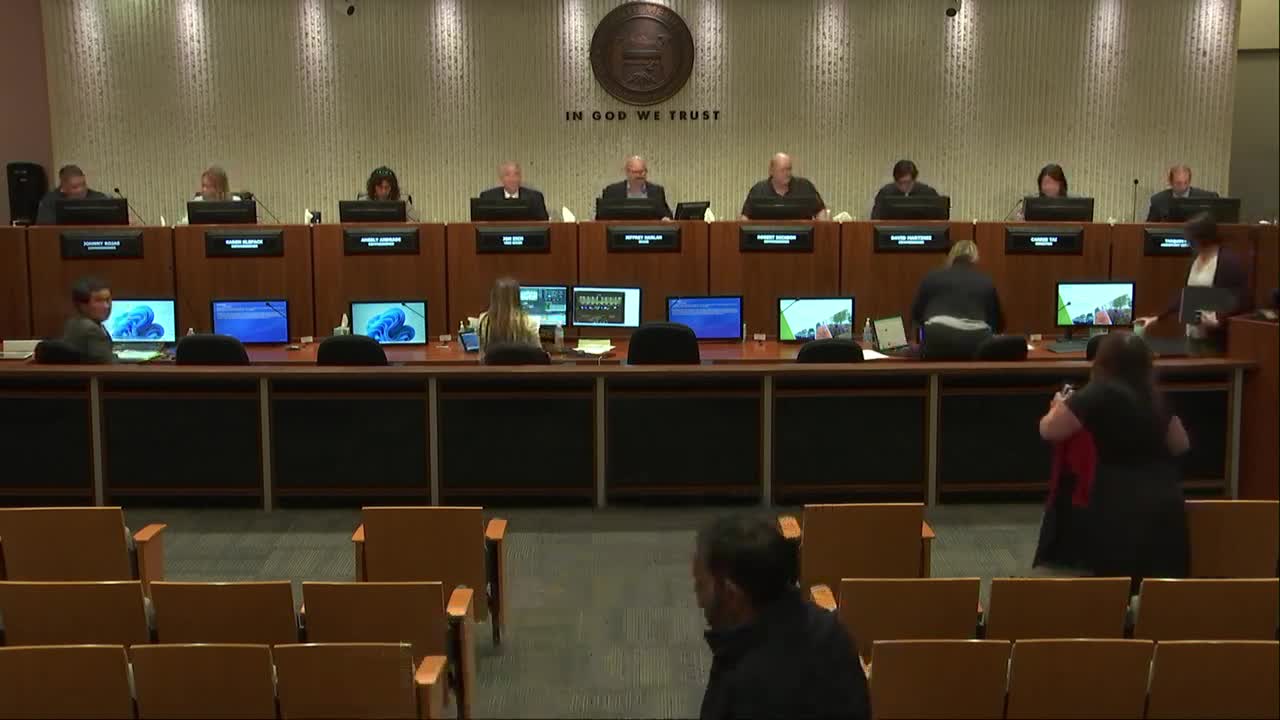Commission recommends land‑use amendments to align Costa Mesa general plan with housing element; motion passes 5‑2
October 14, 2025 | Costa Mesa, Orange County, California
This article was created by AI summarizing key points discussed. AI makes mistakes, so for full details and context, please refer to the video of the full meeting. Please report any errors so we can fix them. Report an error »

The Costa Mesa Planning Commission on Monday voted 5‑2 to recommend that City Council adopt amendments to the General Plan Land Use Element to achieve internal consistency with the city’s sixth‑cycle housing element (2021–2029).
Staff said the update is a technical reconciliation that memorializes the housing element record and the city’s list of housing opportunity sites. The housing element, adopted in 2022, identifies 97 housing opportunity sites and a Regional Housing Needs Allocation (RHNA) of 11,760 units. Measure K (voter initiative, effective Nov. 18, 2022) authorizes changes to land use and zoning to accommodate housing and was used to create the pool of candidate sites.
Principal Planner Melinda Daisy told the commission the proposed land‑use amendments add clarifying language and footnotes throughout the Land Use Element so that the provision of housing opportunity sites and the housing element capacity are not restricted by other Land Use Element language or development standards. Staff recommended the commission find no new environmental review is required under CEQA and rely on prior environmental documents, citing the previously adopted mitigated negative declaration and the CEQA guideline for subsequent review.
Commissioners asked detailed questions about the housing element, RHNA, Measure K, timing and scope of future rezoning, and how the city will ensure the sites can yield the densities in the housing element. Commissioner Martinez moved the recommendation, with a technical edit changing several references from “reductions” to “modifications” in figure LU‑4 and LU‑6; Commissioner Andrade seconded. Vice Chair Zick and Commissioner Dixon voted no.
In debate, Vice Chair Zick said the subject deserved broader public attention and expressed substantive objections to removing or relaxing development standards citywide, including height limits, the fiscal consequences of rezoning commercial and industrial land, and the potential loss of open space. In his remarks he said, “I’m not supporting the motion because I’m not gonna let it happen by 1 vote,” summarizing strong reservations about the pace and scope of the implementation.
Staff told the commission the next step is to bring zoning code and specific‑plan amendments back to the Planning Commission as part of the neighborhoods‑for‑all (rezoning) program, with targeted outreach and objective standards to be developed in 2026. City Council is scheduled to receive the Planning Commission recommendation on Nov. 4, 2025. Staff also noted HCD (Department of Housing and Community Development) previously issued revision letters during the housing element process and that the city must reconcile its administrative record; staff characterized the current land‑use amendment as a nunc pro tunc correction to create internal consistency.
The motion passed 5‑2. Commissioners Zick and Dixon recorded dissenting votes. The commission’s recommendation will now be transmitted to City Council for final action; affected parcels and the rezoning program will require subsequent public hearings and, where applicable, implementation measures such as specific plan or zoning text changes and CEQA review.
Staff said the update is a technical reconciliation that memorializes the housing element record and the city’s list of housing opportunity sites. The housing element, adopted in 2022, identifies 97 housing opportunity sites and a Regional Housing Needs Allocation (RHNA) of 11,760 units. Measure K (voter initiative, effective Nov. 18, 2022) authorizes changes to land use and zoning to accommodate housing and was used to create the pool of candidate sites.
Principal Planner Melinda Daisy told the commission the proposed land‑use amendments add clarifying language and footnotes throughout the Land Use Element so that the provision of housing opportunity sites and the housing element capacity are not restricted by other Land Use Element language or development standards. Staff recommended the commission find no new environmental review is required under CEQA and rely on prior environmental documents, citing the previously adopted mitigated negative declaration and the CEQA guideline for subsequent review.
Commissioners asked detailed questions about the housing element, RHNA, Measure K, timing and scope of future rezoning, and how the city will ensure the sites can yield the densities in the housing element. Commissioner Martinez moved the recommendation, with a technical edit changing several references from “reductions” to “modifications” in figure LU‑4 and LU‑6; Commissioner Andrade seconded. Vice Chair Zick and Commissioner Dixon voted no.
In debate, Vice Chair Zick said the subject deserved broader public attention and expressed substantive objections to removing or relaxing development standards citywide, including height limits, the fiscal consequences of rezoning commercial and industrial land, and the potential loss of open space. In his remarks he said, “I’m not supporting the motion because I’m not gonna let it happen by 1 vote,” summarizing strong reservations about the pace and scope of the implementation.
Staff told the commission the next step is to bring zoning code and specific‑plan amendments back to the Planning Commission as part of the neighborhoods‑for‑all (rezoning) program, with targeted outreach and objective standards to be developed in 2026. City Council is scheduled to receive the Planning Commission recommendation on Nov. 4, 2025. Staff also noted HCD (Department of Housing and Community Development) previously issued revision letters during the housing element process and that the city must reconcile its administrative record; staff characterized the current land‑use amendment as a nunc pro tunc correction to create internal consistency.
The motion passed 5‑2. Commissioners Zick and Dixon recorded dissenting votes. The commission’s recommendation will now be transmitted to City Council for final action; affected parcels and the rezoning program will require subsequent public hearings and, where applicable, implementation measures such as specific plan or zoning text changes and CEQA review.
View full meeting
This article is based on a recent meeting—watch the full video and explore the complete transcript for deeper insights into the discussion.
View full meeting
